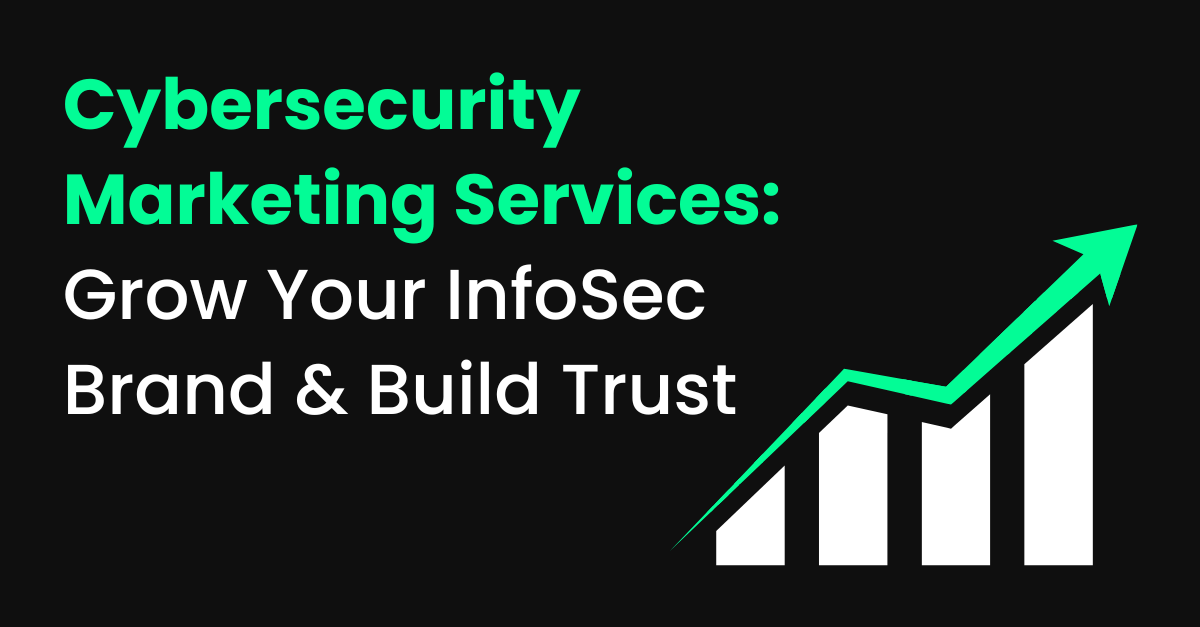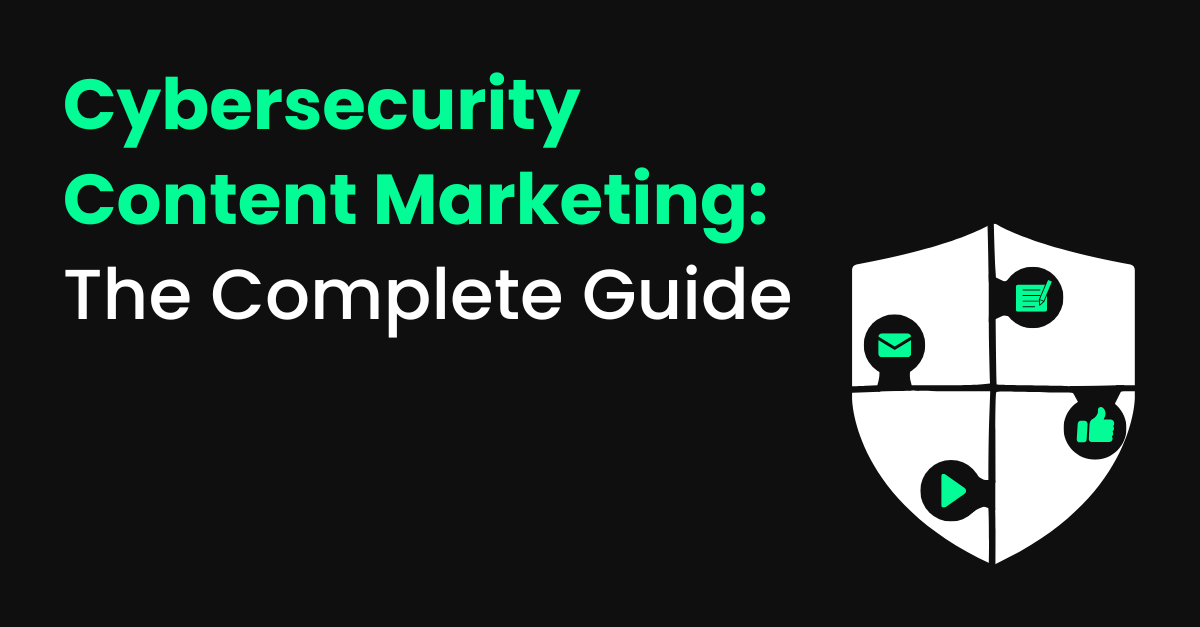Introduction
If you work in cybersecurity marketing, you already know it’s not your average B2B game. You’re trying to reach people trained to be skeptical CISOs, IT leaders, and security pros who’ve heard every “cutting-edge” pitch before. The challenge isn’t just getting their attention; it’s earning their trust. That’s what makes a strong cybersecurity marketing strategy so important. In this guide, we’ll break down how to cut through the noise, tell more credible stories, and build lasting trust so your brand stands out in one of the most competitive markets.
What is Cybersecurity Marketing?
Cybersecurity marketing is how cybersecurity companies communicate trust, not just technology. It’s a specialized cybersecurity marketing strategy that helps explain cybersecurity solutions, products, and services to a cautious target audience of CISOs, IT leaders, and decision makers.
Unlike broad B2B marketing strategies, marketing cybersecurity services focuses on credibility, education, and empathy. The goal is to demonstrate how your cybersecurity products safeguard sensitive data, mitigate cyber threats, and ensure business continuity, all while generating high-quality leads. Cybersecurity marketers connect with potential customers through digital, email, and content marketing, using clear value propositions, authentic storytelling, and social proof.
Because cybersecurity marketing requires technical depth and emotional intelligence, your marketing efforts need to go beyond buzzwords. Effective campaigns use thought leadership, account-based marketing, and personalized messaging to establish authority and nurture leads through multiple marketing channels.
A cybersecurity marketing agency can help you develop tailored solutions, optimize search engines for visibility, and align marketing messages with the pain points that matter most. In a highly competitive cybersecurity industry, companies that succeed simplify complex ideas, provide practical advice, and leverage their thought leadership to foster lasting relationships and generate qualified leads.
Why Cybersecurity Marketing Strategy Matters in 2025
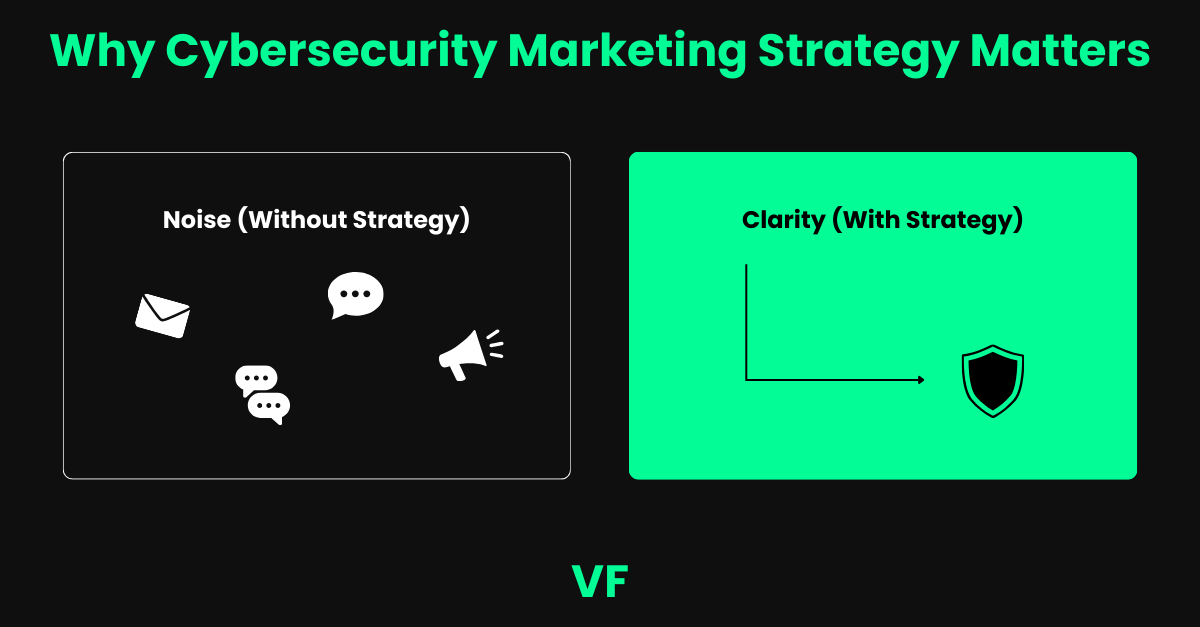
The cybersecurity industry is noisy; New cybersecurity companies and vendors appear every week, all claiming to have the ultimate solution. That’s exactly why a strong cybersecurity marketing strategy matters in 2025.
You can’t just shout louder; you need to stand out by being clear, credible, and genuinely helpful. The goal isn’t just to market cybersecurity services, but to connect with your target audience, earn trust, and show how your cybersecurity solutions protect sensitive data and keep business continuity intact.
Buyers today are more cautious than ever; they’ve seen every pitch and every “next-gen” promise. What cuts through is authenticity marketing efforts that solve real pain points, offer practical advice, and build relationships.
Whether it’s thought leadership, content marketing, or personalized campaigns, cybersecurity marketers focusing on value over volume will generate qualified leads, nurture long-term trust, and become the voices people listen to in this competitive space.
The Core Pillars of a Cybersecurity Marketing Strategy

Audience & Persona Development
If you try to talk to everyone in cybersecurity, you’ll connect with no one. The first step in any strong cybersecurity marketing strategy is clarifying your audience, including CISOs, IT directors, compliance managers, or procurement teams. Each has unique pain points and goals.
CISOs prioritize reducing cyber threats and risk exposure, while compliance professionals focus on audit-readiness and peace of mind. Build detailed personas, utilize intent data, and engage with cybersecurity forums to gain insights into how your target audience discusses their challenges. The more you understand their world, the easier it is to create marketing messages that hit home and generate high-quality leads.
Positioning & Messaging
Your positioning is where most cybersecurity companies either stand out or get lost in the noise. “We keep you secure” won’t cut it anymore. You need a value proposition that links security → trust → ROI. Show how your cybersecurity products and services help businesses stay compliant, protect sensitive data, and maintain business continuity, all in plain language.
Use social proof, such as customer success stories and certifications, to support your claims. The more authentic your story feels, the more your marketing efforts will build credibility and trust with potential customers who are tired of hearing the same recycled claims.
Multi-Channel Content & Thought Leadership
Cybersecurity marketers who win don’t just publish blog posts; they educate. Use content marketing to teach, not sell. Mix SEO-driven articles, whitepapers, webinars, and podcasts that dive into real threat intelligence trends or explain how cybersecurity solutions solve everyday problems.
Combine organic reach from search engines with social media promotion and digital marketing tools like retargeting ads or Google Ads. Consistency is key. The more value you give across different marketing channels, the faster you establish authority and generate qualified leads.
Account-Based Marketing (ABM) & Targeting
For B2B cybersecurity providers, account-based marketing (ABM) is where the magic happens. Instead of spreading your energy across hundreds of prospects, focus on a few high-value accounts.
Define your ideal customer profile (ICP), maybe Fortune 1000 companies in finance or healthcare, and build personalized campaigns around their specific pain points. Use tailored email sequences, targeted LinkedIn ads, and personalized messaging to build relationships with key decision makers.
Trust & Credibility Building
In cybersecurity, trust isn’t a bonus; it’s the whole game. Your potential clients are entrusting you with sensitive data, so your cybersecurity marketing campaigns should focus on establishing credibility.
Share testimonials, certifications, analyst reports, and success stories that show you walk the talk. Align your marketing cybersecurity services with industry standards like ISO 27001 or SOC 2, and focus on thought leadership that positions you as a reliable partner. Remember, trust is built in layers: consistency, transparency, and delivering real value every time.
Full-Funnel Cybersecurity Marketing Strategy
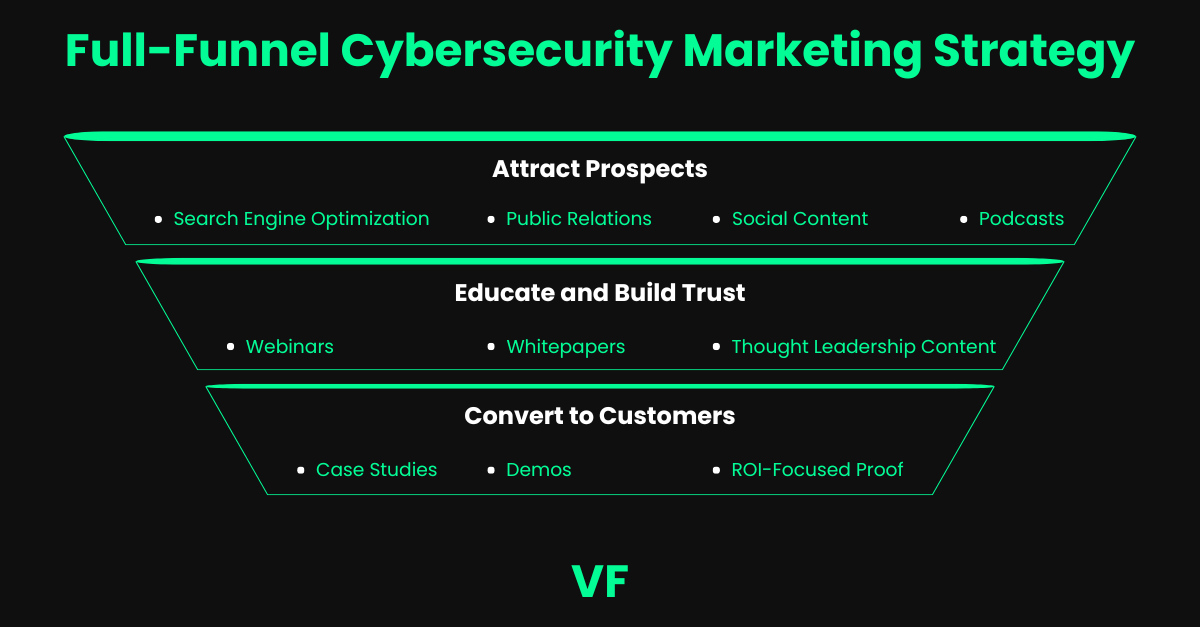
Top of Funnel (TOFU): Awareness
At this stage, your cybersecurity marketing strategy is about showing up everywhere your buyers hang out. Utilize SEO, PR, podcasts, and social media to establish awareness and trust before pitching. Cybersecurity companies can leverage content marketing to demystify cyber threats, explain compliance changes, or highlight threat intelligence insights. These early marketing efforts help your target audience find you when they search for practical answers on search engines or in cybersecurity forums.
Instead of pushing cybersecurity products, focus on educating. Share stories about how strong cybersecurity solutions protect sensitive data and keep business continuity intact. When your digital marketing feels helpful and human, you increase brand awareness and attract high-quality leads who already see you as a thought leader, not another vendor shouting about fear.
Middle of Funnel (MOFU): Nurturing
Once you’ve caught their attention, your job is to build relationships and earn trust. Webinars, gated guides, and email marketing campaigns are ideal tools for this purpose. Cybersecurity marketers should craft personalized messaging that speaks directly to a CISO’s or IT director’s pain points, maybe cutting through alert fatigue or improving cloud security posture. These content marketing pieces demonstrate a deep understanding of your potential customers’ real challenges, positioning your brand as a reliable partner.
Utilize intent data and account-based marketing to prioritize qualified leads, and then nurture them with consistent, educational touchpoints. The most effective cybersecurity marketing campaigns don’t just sell cybersecurity services; they teach, reassure, and simplify complex topics. Over time, this steady stream of practical advice and thought leadership creates loyal followers who already trust your expertise before the first sales call.
Bottom of Funnel (BOFU): Conversion
Here’s where awareness turns into action. Your marketing strategies should highlight proof, not promises. Share ROI-driven case studies, product demos, and success stories showing how your cybersecurity services reduced data breaches or saved hours in incident response. Add social proof, analyst mentions, certifications, and customer testimonials to establish authority and show you deliver real results.
BOFU success depends on alignment. Your sales outreach and marketing messages must feel seamless. A good cybersecurity marketing agency or internal team arms the sales side with clear talking points, one-pagers, and demo scripts to convert qualified leads with confidence. At this point, marketing cybersecurity services is less about lead generation and more about trust conversion: proving you’re the partner who can truly protect what matters most.
Cybersecurity Go-to-Market (GTM) Strategy
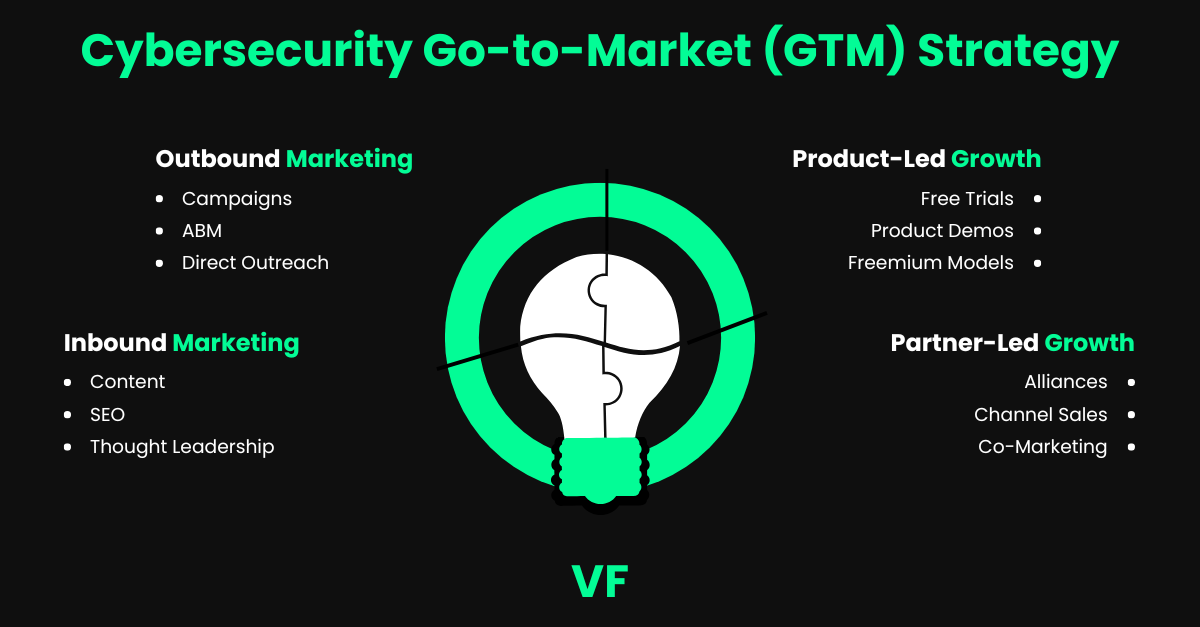
A go-to-market (GTM) strategy serves as your roadmap for transforming cybersecurity solutions into tangible, trusted business outcomes. It’s about connecting your product to the right audience, CISOs, IT teams, and compliance leaders by demonstrating why your solution matters.
In such a competitive cybersecurity space, having a clear GTM plan keeps your messaging, content, and sales outreach focused so every marketing effort actually drives results, not noise.
The best GTM strategies blend product-led, inbound, and outbound marketing. Product-led growth lets people experience value firsthand, inbound builds trust with helpful content marketing, and outbound, like account-based marketing or personalized emails, gets you in front of key decision makers.
Add strong partnerships with MSPs or other cybersecurity providers, and you’ve got an ecosystem that builds credibility and scales faster than any single channel could alone.
Common Challenges in Cybersecurity Marketing

If you’ve worked in cybersecurity marketing for any amount of time, you know it’s not your typical B2B game. The stakes are higher, buyers are cautious, and everyone claims to have the best “next-gen” solution. Still, with a clear cybersecurity marketing strategy and a smart mix of marketing strategies, you can turn tough challenges into consistent lead generation wins.
Long Sales Cycles → Keep the Conversation Alive
Selling cybersecurity services involves working with cautious decision makers, including CISOs and IT leaders, who are reluctant to rush into contracts. Your marketing efforts need to keep these folks engaged over time. Think nurture sequences packed with useful insights, webinars that tackle real cyber threats, and email marketing that feels human, not corporate.
Share content marketing that actually helps them do their job better, guides, threat intelligence breakdowns, and compliance checklists. The goal is to keep your target audience engaged until they’re ready to discuss practical solutions, not just theoretical security concepts.
Technical Messaging → Make It About What They Gain
One of the biggest traps cybersecurity marketers fall into is talking like engineers instead of problem solvers. Buyers care less about “advanced encryption algorithms” and more about avoiding downtime, preventing data breaches, and protecting revenue.
When crafting marketing messages for cybersecurity products and services, translate the technology into tangible outcomes. Use storytelling in your content marketing and digital marketing to show what success looks like. Focus on business continuity, not buzzwords; that’s how you connect with potential customers and build trust.
Tight Budgets → Focus on Channels That Actually Deliver
You don’t need a massive ad budget to succeed in cybersecurity marketing; what you need is precision. Spend your energy on marketing channels that generate high-quality leads: SEO, paid retargeting ads, and account-based marketing.
Review the data (intent data, engagement rates, and conversion trends) and eliminate any non-essential elements. If a campaign doesn’t move the needle, reallocate that spend to content or lead generation activities that do. In a highly competitive industry, efficiency beats volume every time.
Fierce Competition → Lead With Trust and Expertise
Every cybersecurity company says they’re “the best.” That’s noise. What cuts through is credibility. Share customer success stories, highlight third-party certifications, and position your leadership team as visible thought leaders. Use your social media and blog to educate, not just promote.
Mix in SEO-backed content that builds authority while helping potential clients solve real problems. Over time, this kind of thought leadership doesn’t just build awareness; it earns trust, which is what cybersecurity marketing really runs on.
Best Practices for Cybersecurity Marketing Strategy
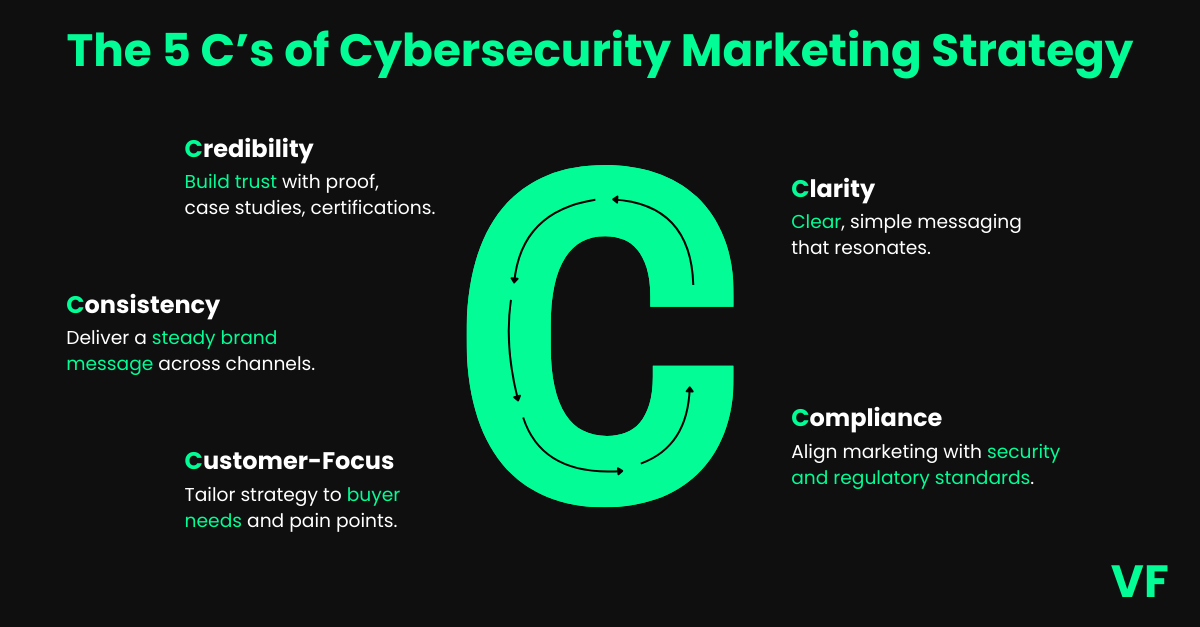
There’s no one-size-fits-all playbook for cybersecurity marketing. Still, some patterns distinguish average marketing strategies from those that win trust, generate high-quality leads, and build lasting impact. The 5 C’s of cybersecurity marketing aren’t buzzwords; they’re the habits that make cybersecurity companies stand out in a highly competitive industry.
Clarity: Simplify Your Message Without Dumbing It Down
In cybersecurity marketing, clarity is your secret weapon. Your target audience, CISOs, compliance managers, and IT directors, is overwhelmed by complex pitches and buzzwords. They don’t want to “decode” your marketing messages; they want to know how your cybersecurity services protect sensitive data, prevent cyber threats, and make their life easier.
Whether it’s your website copy, email marketing, or digital marketing assets, explain your cybersecurity solutions in plain language that feels human. The clearer your story, the faster you’ll build trust and attract qualified leads.
Credibility: Show, Don’t Just Tell
Everyone says they’re an “industry leader,” but few can prove it. Credibility in a cybersecurity marketing strategy comes from social proof and substance. Use client success stories, analyst mentions, and case studies that highlight measurable results, not just marketing fluff.
Show how your cybersecurity products helped clients stop data breaches or strengthen business continuity. Thought leadership content, such as webinars and podcasts, can position your team as experts, not just sellers. The more evidence you provide, the more likely your potential customers are to believe that your cybersecurity solutions deliver real value.
Consistency: Build Momentum Across Every Channel
If your cybersecurity marketing efforts only show up once in a while, you’ll lose momentum fast. Consistency builds recognition and recognition builds trust. Stay visible through ongoing content marketing, social media, and SEO-driven marketing campaigns.
Repurpose your best-performing content across marketing channels to maximize visibility with your target audience. Whether it’s blog posts, retargeting ads, or account-based marketing campaigns, keep your voice, tone, and value proposition consistent. That steady presence is how cybersecurity marketers generate high-quality leads over time instead of one-off wins.
Customer-Focus: Speak to Real Pain Points, Not Product Features
Cybersecurity marketing requires empathy, a deep understanding of what your potential customers actually face day-to-day. CISOs and IT professionals don’t wake up thinking about “multi-layered security architecture”; they think about preventing data breaches, maintaining compliance, and keeping their teams safe.
Use intent data and personalized messaging to speak to those pain points directly. Create content marketing that helps, not sells, practical advice, how-to guides, or insights from threat intelligence experts. The more you show that you understand their world, the faster you’ll generate high-quality, qualified leads who actually want to talk.
Compliance: Turn Trust Into a Selling Point
For cybersecurity companies, compliance isn’t just paperwork; it’s part of the brand promise. Utilize your cybersecurity marketing campaigns to demonstrate how your products and services align with key frameworks such as ISO, NIST, and SOC 2.
Buyers in the cybersecurity sector want to know you take their data protection seriously. Create educational content explaining why compliance matters and how your cybersecurity products and services help maintain it. When you position compliance as a benefit, not a barrier, it becomes a natural driver for lead generation and customer loyalty.
Pro Tip: Build Community and Focus on Retention
The most effective cybersecurity marketing strategies don’t stop at the sale; they nurture relationships. Stay active in cybersecurity forums, sponsor industry events, and engage your existing clients through thought leadership updates and ongoing support. Your current customers are your best marketing channel.
Continue to deliver excellent customer service and share their success stories to build social proof. Over time, these efforts transform your cybersecurity marketing agency into a trusted voice, and your brand into one that clients are proud to recommend.
How to Build Your Cybersecurity Marketing Strategy
Building an effective cybersecurity marketing strategy requires more than just a few campaigns; it involves creating a system that generates high-quality leads, builds trust, and establishes your brand as a thought leader in a highly competitive industry. Here’s how to do it step by step.
1. Define Your Personas & Ideal Customer Profile (ICP)
Start by knowing exactly who you’re talking to. In cybersecurity marketing, your target audience typically includes CISOs, IT directors, compliance officers, and occasionally CEOs concerned about cyber threats or data breaches. Map out their pain points. What keeps them up at night? Maybe it’s business continuity, audit pressure, or protecting sensitive data.
Then define your Ideal Customer Profile (ICP). Utilize intent data, CRM insights, and industry signals to identify which cybersecurity companies or verticals are most responsive to your products and services.
This helps you prioritize marketing efforts that actually generate qualified leads. Don’t be afraid to segment messaging between enterprise accounts (for account-based marketing) and SMBs; they buy differently, and your marketing channels should reflect that.
2. Craft Messaging That Feels Human and Different
Most cybersecurity marketers default to fear: “Stop breaches before they happen.” But fear alone doesn’t sell; trust does. Create marketing messages that clearly explain why your cybersecurity solutions matter. Tie your value proposition to ROI, peace of mind, and compliance confidence.
For every persona, tailor your message to achieve key outcomes: reduced downtime, increased control, and improved business continuity. Use personalized messaging that shows a deep understanding of your potential customers’ day-to-day challenges. Ensure your website, email marketing, and digital marketing assets convey a unified message: you understand the challenges of protecting sensitive data under pressure.
3. Map a Full-Funnel Plan That Matches the Buyer Journey
Cybersecurity marketing requires a long-game approach. You’re not selling t-shirts, you’re asking organizations to trust you with their infrastructure. Design a funnel that matches how your target audience actually buys:
- Top of Funnel (TOFU): Use SEO, PR, and content marketing to increase brand awareness and attract a broad audience. Think threat intelligence articles, cybersecurity webinars, or thought leadership posts on social media.
- Middle of Funnel (MOFU): Create gated guides, nurture emails, and retargeting ads that educate and build trust.
- Bottom of Funnel (BOFU): Focus on ROI case studies, demos, and free trials that prove your cybersecurity services deliver measurable impact.
Every funnel stage should connect. The goal isn’t just to generate leads, but to nurture leads into high-quality, qualified opportunities.
4. Choose the Right Mix of Marketing Services (SEO, PR, ABM, Content)
Here’s where strategy turns into execution. Cybersecurity companies require a combination of digital marketing activities that establish authority and deliver results.
- SEO keeps you visible in search engines when potential clients look for cybersecurity solutions.
- Content marketing positions you as a thought leader, using blogs, whitepapers, and webinars that tackle cyber threats in plain English.
- PR earns credibility through analyst reports and media coverage.
- Account-Based Marketing (ABM) helps you personalize outreach to enterprise accounts with tailored solutions.
A strong cybersecurity marketing agency can help coordinate these moving parts for maximum effectiveness, but even in-house teams can create impact by aligning these marketing channels under one strategy.
5. Align With Sales and Track What Actually Works
Your marketing strategy doesn’t end when a lead downloads an ebook. Work closely with your sales outreach team to make sure your marketing efforts align with their conversations. Use shared dashboards to track lead generation, sales velocity, and conversion rates.
Analyze which marketing campaigns actually produce qualified leads. Perhaps your webinars are outperforming your Google Ads, or your social media content is generating more demos than anticipated. Drop what’s not working and double down where you’re getting traction. This kind of agility turns a good cybersecurity marketing strategy into a growth engine.
And one last thing, talk to your sales reps regularly. They understand the questions potential customers are asking, the pain points that resonate, and where your content marketing can address the gaps. Marketing and sales alignment is where the real ROI happens.
Conclusion
A strong cybersecurity marketing strategy isn’t just a nice-to-have — it’s the difference between blending in and becoming the go-to name in a crowded market.When your strategy is built on trust, consistency, and clarity, you’re not just generating leads — you’re building lasting relationships with decision-makers who believe in your solution. Keep showing up. Keep providing value. Keep refining based on what actually drives results. Ready to strengthen your cybersecurity marketing strategy and start driving measurable growth? Book a discovery call


